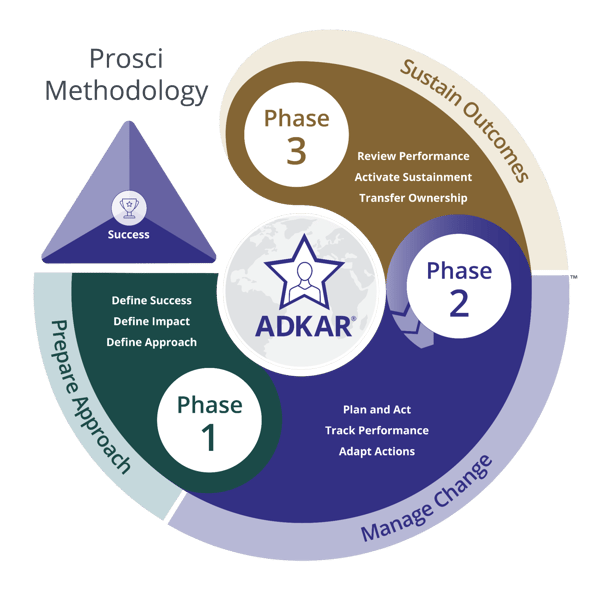Is the Change Curve Right for Your Organization’s Needs?

5 Mins
Updated: August 11, 2025
Published: September 17, 2024

Adopting organizational change is an emotional process for employees, which is where the Change Curve can help. It’s a model that breaks down an individual’s emotional experience throughout organizational change.
But is it the right framework for managing change in your organization? Are there any limitations to the framework, and does it incorporate any practical aspects of managing change?
In this article, we outline how the Change Curve works, whether it’s useful for managing organizational change, and how it compares with the Prosci Methodology.
What Is a Change Curve (and How Does It Relate to the Kübler-Ross Model)?
The Change Curve is a model that describes the psychological stages people go through when experiencing significant change. It’s based on the Kübler-Ross model, which outlines the stages of grief as seen through terminally ill patients.
This concept of loss was then transferred to any type of loss, including those in a corporate setting. It’s used in business and organizational settings to help manage and understand employees' reactions to change, such as restructuring, new policies or technological shifts.
What Are the 5 Stages of the Change Curve Model?
The Change Curve model has five stages, all of which are adapted from the Kübler-Ross stages of grief:
- Denial
- Anger
- Bargaining
- Depression
- Acceptance

Let’s look at these stages in more detail, including how they impact individuals during the change management process.
- Denial – This is the initial shock that individuals experience when they’re in disbelief about the change. It can be so strong that they may deny its significance or impact.
- Anger – After denial, people may express anger, resentment, or other emotional obstacles that some organizations might consider resistance to change. It often emerges as emotional turmoil from individuals who haven't been prepared properly for change, which results in pushback against the change.
- Bargaining – When the anger settles, individuals may try to negotiate to avoid the change completely. In this stage, they may also experience self-doubt, questioning their abilities and future within the company.
- Depression – As the name suggests, this stage involves individuals feeling deep sadness, helplessness or despair as they start to come to terms with the change. It’s often a period of lower productivity and morale across the business.
- Acceptance – After navigating all the emotions, individuals finally accept the change and begin to integrate it willingly into their lives. They start to see the benefits and adjust their behaviors and attitudes accordingly, supporting the change and sustaining it in the long term.
Is the Change Curve Still Relevant?
Yes, the Change Curve is still relevant. It provides valuable insights into the emotional responses individuals have to assess, which helps change leaders suppor them and navigate change more effectively.
However, it may not be comprehensive enough to address all aspects of organizational change management.
The Change Curve focuses primarily on individual reactions, not how groups or teams as a whole react to change. This means you may miss the broader influences of change, such as culture, leadership and communication.
This is where using the Prosci Methodology can help. The Kübler-Ross Model is effective at the organizational level when integrated with a complete methodology, like the Prosci Methodology. In fact, many change managers use the Change Curve when supporting people through the Prosci ADKAR® Model.
Let’s explore this in more detail by directly comparing the Change Curve with the Prosci Methodology.
Comparing the Change Curve to the Prosci Change Management Methodology
The Prosci Methodology includes multiple models and tools designed to manage change at both individual and organizational levels:
- Prosci ADKAR Model focuses on individual change with five building blocks: Awareness, Desire, Knowledge, Ability and Reinforcement. It’s based on the understanding that organizational change can only succeed when individuals change. As a result, it guides individuals through a particular change, addressing any roadblocks or concerns along the way.
- Prosci 3-Phase Process is a structured approach for managing change at the organizational level, divided into three phases: Phase 1– Prepare Approach, Phase 2 – Manage Change, and Phase 3 – Sustain Outcomes. When following three phases, organizations can work through all the essential activities that lead to successful change.
- Prosci Change Triangle (PCT) Model integrates leadership and sponsorship, project management, change management, and success. It helps change practitioners understand these four critical aspects of change and how they support project health.
The Prosci 3-Phase Process

Together, these frameworks provide a well-rounded and structured approach to change management—but how does the Change Curve fit into the picture?
Simply put, the Change Curve highlights the humanity aspect of people going through change, while the Prosci Methodology helps to structure efficient change.
Let’s look at some of the other ways the Change Curve blends with the Prosci Methodology.
To better understand the emotional impact of change
The Change Curve is more aligned with the type of emotional journey the stakeholder is going through. When used alongside the structured and detailed frameworks in the Prosci Methodology, this enables change leaders to better understand how individuals feel through each stage of change.

This helps you tackle change from different perspectives, ensuring you have the structure to implement it successfully and the emotional understanding to support employees throughout the process.
Widening the components of change management
Kübler-Ross has five emotional stages, meaning that it’s quite singular in its structure. It focuses solely on these five emotional experiences as an approach to managing change. The Prosci Methodology, on the other hand, includes multiple models and phases to address different aspects of change management.
By combining these two approaches, you can approach change from a more holistic perspective.
Adopting a people-focused approach to change
The Change Curve prioritizes people’s emotions throughout change. It’s a great way to ensure that people are emotionally supported throughout the different parts of change—one of the key ways Prosci approaches differ from others.
However, the Change Curve doesn’t address the other key aspects of change, like ensuring individuals have the awareness, desire and ability to change. The ADKAR Model, for example, is tailored to address the human side of change, ensuring that individuals are supported throughout the transition with resources, tools and training.
Using the Change Curve and Prosci frameworks in unison, you can approach change with all of these perspectives.
Combining emotion with research-based practices
Some studies show how the Change Curve can support change projects, but the method itself isn’t founded on change management research. It originated from Elisabeth Kübler-Ross, who published the five stages of grief in The International Journal of Psychiatry in Medicine in 1969 and 1970.
The Prosci Methodology, however, is based on over two decades of research about change management. It’s designed specifically to be adaptable and scalable to different types and sizes of organizational change initiatives, making it a reliable and effective approach.
With the Prosci data-backed approach, you can ensure that you enact change as successfully as possible. Add the Change Curve into the mix, and you can also support employees emotionally throughout this process.
Access to tools and resources
With the Change Curve, you can use the five stages to manage change, but that’s all the support you can access—aside from going way back and reading the original publication of the five stages of grief in The International Journal of Psychiatry in Medicine.
In other words, you’re limited in the support you can get when using this framework. But if you use it alongside the Prosci Methodology? You have access to a range of tools, assessments and training resources to support you when implementing effective change strategies.
 You also have access to change management experts who understand your industry. These experts can help you implement our ADKAR Model to minimize the impact of some of the negative elements of the Change Curve.
You also have access to change management experts who understand your industry. These experts can help you implement our ADKAR Model to minimize the impact of some of the negative elements of the Change Curve.
For example, reducing Denial by increasing Awareness. This involves answering the question: Why is the change necessary, and what are we trying to achieve? When people understand the reason behind the change, they’re less likely to resist it.
Use the Prosci Methodology To Enact Effective Change
The Change Curve offers valuable insights into the emotional journey of change, while the Prosci Methodology provides a comprehensive, research-driven and people-focused approach to change management.
By addressing both the emotional and practical aspects of change, the Prosci Methodology ensures higher success rates and smoother transitions for organizations. In fact, organizations that apply effective change management are seven times more likely to meet or exceed objectives.




